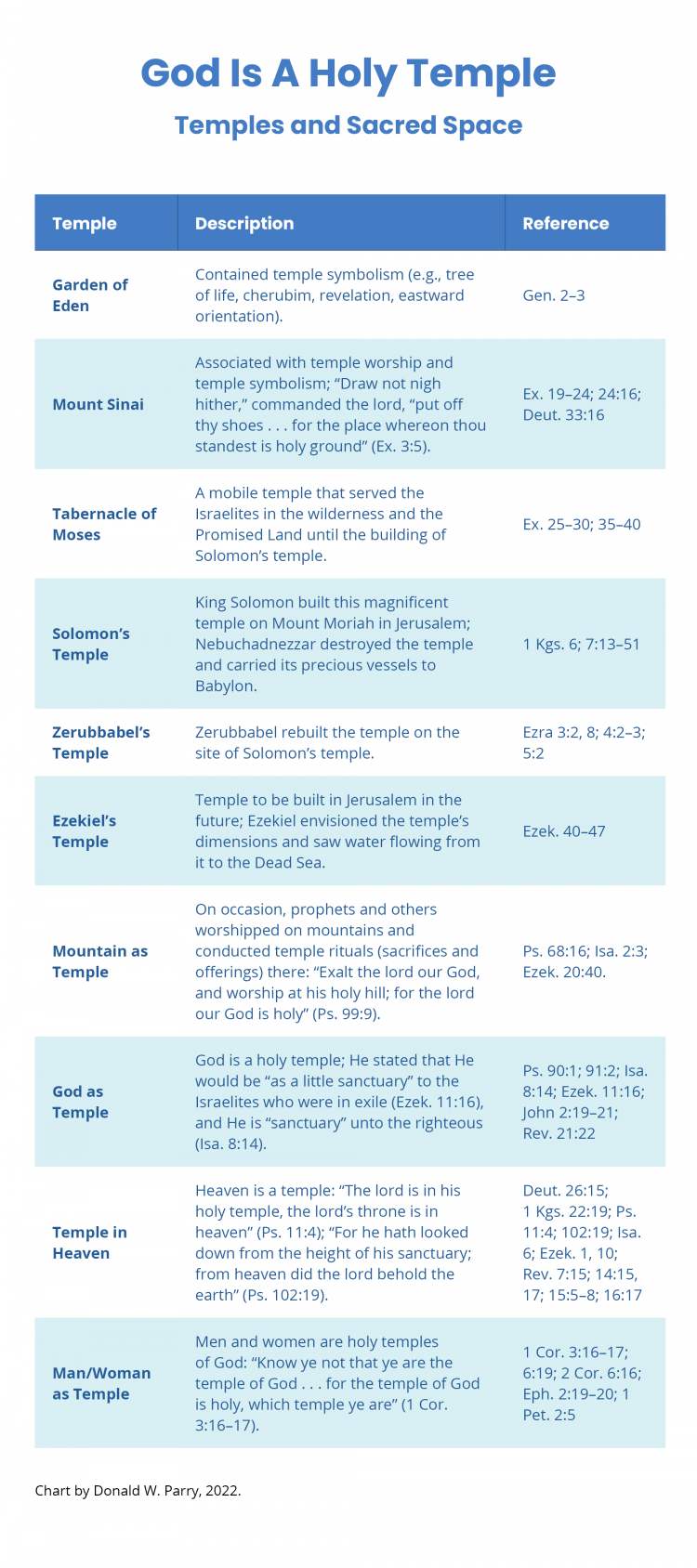You are here
God Is a Holy Temple: Temples and Sacred Space
| Title | God Is a Holy Temple: Temples and Sacred Space |
| Publication Type | Book Chapter |
| Year of Publication | 2022 |
| Authors | Parry, Donald W. |
| Book Title | The Jesus Christ Focused Old Testament: Making Sense of a Monumental Book |
| Chapter | 52 |
| Pagination | 136-137 |
| Publisher | Book of Mormon Central |
| City | Springville, UT |
Show Full Text
The scriptures identify a number of temples and temple structures,[1] all of which serve to reveal the lord Jesus Christ and His mission, attributes, and divine character.
Many temples are formal structures built by human hands, such as the Mosaic Tabernacle and Solomon’s Temple; others are natural places like the Garden of Eden, Mount Sinai, and mountain settings; still others include the Temple in Heaven, God Himself, and man and woman. These various temples and temple structures are identified in the accompanying chart.
All temples and related components serve God’s divine purposes and exist for the salvation of the human family. There is a formal connection among all temple types—God (Himself a holy temple) reveals sacred laws and rituals to His children (who are holy temples) in holy temple buildings or within natural temples. That is to say, temple buildings and natural temples accommodate God and His children in spaces that are holy, or separate, set apart from the world and from profane things.
Furthermore, various components of the tabernacle foreshadowed aspects of Jesus Christ’s divine ministry and atoning sacrifice. These components include the tabernacle furniture (laver of brass, altars, lampstand, mercy seat), sacrifices, foods (shewbread), sacred objects (jar of manna, two tablets of stone, rod of Aaron), and various parts of the tabernacle (veil, horns of the altar). The rituals and performances (i.e., anointings, washings, sprinkling of blood, laying on of hands), too, typified Jesus Christ and His mission.
Perhaps most importantly, even the tabernacle itself represented the lord’s body. In Ezekiel the lord told the Jews, who were scattered among the nations, that He would be “as a little sanctuary” to them (Ezek. 11:16). The Psalmist records Moses’s prayer: “lord, thou hast been our dwelling place in all generations” (Ps. 90:1). In his epistle to the Hebrews, Paul called Jesus “a greater and more perfect tabernacle” (Heb. 9:11). And the lord Himself compared Himself to the temple when He said, “Destroy this temple, and in three days I will raise it up.” The Jews, who thought that He referred to the temple of Herod responded, “Forty and six years was this temple in building, and wilt thou rear it up in three days? But he spake of the temple of his body” (John 2:19–22). Jesus’s resurrected body became a new and perfect Tabernacle.
|
Temple |
Description |
Reference |
|---|---|---|
|
Garden of Eden |
Contained temple symbolism (e.g., tree of life, cherubim, revelation, eastward orientation). |
Gen. 2–3 |
|
Mount Sinai |
Associated with temple worship and temple symbolism; “Draw not nigh hither,” commanded the lord, “put off thy shoes . . . for the place whereon thou standest is holy ground” (Ex. 3:5). |
Ex. 19–24; 24:16; Deut. 33:16 |
|
Tabernacle of Moses |
A mobile temple that served the Israelites in the wilderness and the Promised Land until the building of Solomon’s temple. |
Ex. 25–30; 35–40 |
|
Solomon’s Temple |
King Solomon built this magnificent temple on Mount Moriah in Jerusalem; Nebuchadnezzar destroyed the temple and carried its precious vessels to Babylon. |
1 Kgs. 6; 7:13–51 |
|
Zerubbabel’s Temple |
Zerubbabel rebuilt the temple on the site of Solomon’s temple. |
Ezra 3:2, 8; 4:2–3; 5:2 |
|
Ezekiel’s Temple |
Temple to be built in Jerusalem in the future; Ezekiel envisioned the temple’s dimensions and saw water flowing from it to the Dead Sea. |
Ezek. 40–47 |
|
Mountain as Temple |
On occasion, prophets and others worshipped on mountains and conducted temple rituals (sacrifices and offerings) there: “Exalt the lord our God, and worship at his holy hill; for the lord our God is holy” (Ps. 99:9). |
Ps. 68:16; Isa. 2:3; Ezek. 20:40. |
|
God as Temple |
God is a holy temple; He stated that He would be “as a little sanctuary” to the Israelites who were in exile (Ezek. 11:16), and He is “sanctuary” unto the righteous (Isa. 8:14). |
Ps. 90:1; 91:2; Isa. 8:14; Ezek. 11:16; John 2:19–21; Rev. 21:22 |
|
Temple in Heaven |
Heaven is a temple: “The lord is in his holy temple, the lord’s throne is in heaven” (Ps. 11:4); “For he hath looked down from the height of his sanctuary; from heaven did the lord behold the earth” (Ps. 102:19). |
Deut. 26:15; 1 Kgs. 22:19; Ps. 11:4; 102:19; Isa. 6; Ezek. 1, 10; Rev. 7:15; 14:15, 17; 15:5–8; 16:17 |
|
Man/Woman as Temple |
Men and women are holy temples of God: “Know ye not that ye are the temple of God . . . for the temple of God is holy, which temple ye are” (1 Cor. 3:16–17). |
1 Cor. 3:16–17; 6:19; 2 Cor. 6:16; Eph. 2:19–20; 1 Pet. 2:5 |
Terms of Use
Items in the BMC Archive are made publicly available for non-commercial, private use. Inclusion within the BMC Archive does not imply endorsement. Items do not represent the official views of The Church of Jesus Christ of Latter-day Saints or of Book of Mormon Central.
Bibliographic Citation
Subscribe
Get the latest updates on Book of Mormon topics and research for free

